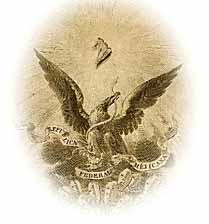

The US-Mexican War began on April 25, 1846. It ended nearly two years later, on February 2, 1848, with the signing of the Treaty of Guadeloupe Hidalgo. Although the war was one of the most momentous conflicts of the nineteenth century, most Americans seem to know little about it today. Frequently, they confuse it with the Texas Revolution (1835-1836), the Spanish-American War (1898), or the border skirmishes with Mexican Revolutionaries that took place between 1913 and 1916. This situation is probably due in part to the overshadowing of the US-Mexican War by the American Civil War, a much larger and more protracted conflict.
Since end of the US-Mexican War, historians have been divided in their interpretations of it. Some have held the United States culpable. Others blame Mexico. Studies of the literature reveal the majority of writers have taken a balanced view, holding neither country completely blameless. Despite the fact that there is no hard evidence to support their views, those who blame the US say that the war was a "shameless land-grab" brought on by the intrigues of President James K. Polk or that it was part of some sinister plot on the part of the so-called "Slavocracy" to extend slavery. These unfounded arguments are nothing new. They are the same ones used by nineteenth century Whig politicians in their attempts to discredit President Polk. The truth is more simple: The war was fought to defend the right of a free people, i.e. the citizens of the Republic of Texas, to determine their own destiny, i.e. to join the American union of states. This was a right that the government of Mexico sought to deny them. Opposition to the war has often been exaggerated. Only a few outspoken Whig politicians, such as John Quincy Adams, were against it. Most Americans enthusiastically supported the war. Approximately 75,000 men eagerly enlisted in volunteer regiments raised by the various states. Thousands more enlisted in the regular US Army. There was no need for a draft. In some places, so many men flocked to recruiting stations that large numbers had to be turned away. Thousands of newly-arrived Irish and German immigrants also heeded the call to arms.
The War with Mexico is notable for a number of "firsts."
The United States' first foreign war.
The first war anywhere in the world to be photographed.
The first war in which steamboats played an important role.
The first war in which newspaper correspondents regularly reported from the seat of war.
The first war in which graduates of the US Military Academy at West Point participated. Among these were a number of officers who would later face each other across the battlefields of the Civil War: Robert E. Lee, Thomas J. "Stonewall" Jackson, Braxton Bragg, Ulysses S. Grant, George Meade, George McClellan, and William T. Sherman, to name but a few.